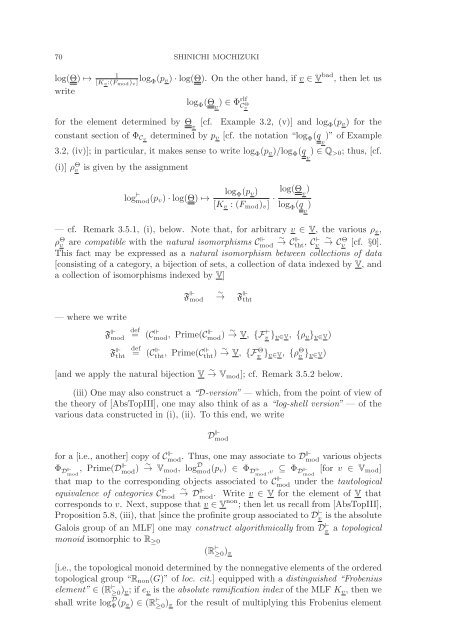Inter-universal Teichmuller Theory I: Construction of Hodge Theaters
Inter-universal Teichmuller Theory I: Construction of Hodge Theaters
Inter-universal Teichmuller Theory I: Construction of Hodge Theaters
Create successful ePaper yourself
Turn your PDF publications into a flip-book with our unique Google optimized e-Paper software.
70 SHINICHI MOCHIZUKI<br />
log(Θ) ↦→<br />
1<br />
[K v :(F mod ) v ] log Φ(p v ) · log(Θ). On the other hand, if v ∈ V bad , then let us<br />
write<br />
log Φ (Θ v<br />
) ∈ Φ rlf<br />
C Θ v<br />
for the element determined by Θ v<br />
[cf. Example 3.2, (v)] and log Φ (p v ) for the<br />
constant section <strong>of</strong> Φ Cv determined by p v [cf. the notation “log Φ (q )” <strong>of</strong> Example<br />
v<br />
3.2, (iv)]; in particular, it makes sense to write log Φ (p v )/log Φ (q ) ∈ Q >0 ;thus,[cf.<br />
v<br />
(i)] ρ Θ v<br />
is given by the assignment<br />
log ⊢ mod(p v ) · log(Θ) ↦→ log Φ(p v )<br />
[K v :(F mod ) v ] ·<br />
log(Θ v<br />
)<br />
log Φ (q<br />
v<br />
)<br />
— cf. Remark 3.5.1, (i), below. Note that, for arbitrary v ∈ V, the various ρ v ,<br />
ρ Θ v are compatible with the natural isomorphisms Cmod<br />
⊩ ∼<br />
→Ctht ⊩ , C⊢ ∼<br />
v →Cv Θ [cf. §0].<br />
This fact may be expressed as a natural isomorphism between collections <strong>of</strong> data<br />
[consisting <strong>of</strong> a category, a bijection <strong>of</strong> sets, a collection <strong>of</strong> data indexed by V, and<br />
a collection <strong>of</strong> isomorphisms indexed by V]<br />
F ⊩ mod<br />
∼<br />
→<br />
F ⊩ tht<br />
—wherewewrite<br />
F ⊩ mod<br />
F ⊩ tht<br />
def<br />
= (C ⊩ mod , Prime(C⊩ mod ) ∼ → V, {F ⊢ v } v∈V , {ρ v } v∈V )<br />
def<br />
= (C ⊩ tht , Prime(C⊩ tht ) ∼ → V, {F Θ v } v∈V , {ρ Θ v } v∈V )<br />
[and we apply the natural bijection V ∼ → V mod ]; cf. Remark 3.5.2 below.<br />
(iii) One may also construct a “D-version” — which, from the point <strong>of</strong> view <strong>of</strong><br />
the theory <strong>of</strong> [AbsTopIII], one may also think <strong>of</strong> as a “log-shell version” —<strong>of</strong>the<br />
various data constructed in (i), (ii). To this end, we write<br />
D ⊩ mod<br />
for a [i.e., another] copy <strong>of</strong> Cmod ⊩ . Thus, one may associate to D⊩ mod<br />
various objects<br />
Φ D<br />
⊩ , Prime(D ⊩<br />
mod<br />
mod ) → ∼ V mod , log D mod(p v ) ∈ Φ D<br />
⊩<br />
mod ,v ⊆ Φ D<br />
⊩ [for v ∈ V mod ]<br />
mod<br />
that map to the corresponding objects associated to Cmod ⊩ under the tautological<br />
equivalence <strong>of</strong> categories Cmod<br />
⊩ ∼<br />
→Dmod ⊩ . Write v ∈ V for the element <strong>of</strong> V that<br />
corresponds to v. Next, suppose that v ∈ V non ; then let us recall from [AbsTopIII],<br />
Proposition 5.8, (iii), that [since the pr<strong>of</strong>inite group associated to Dv ⊢ is the absolute<br />
Galois group <strong>of</strong> an MLF] one may construct algorithmically from Dv<br />
⊢ a topological<br />
monoid isomorphic to R ≥0<br />
(R ⊢ ≥0) v<br />
[i.e., the topological monoid determined by the nonnegative elements <strong>of</strong> the ordered<br />
topological group “R non (G)” <strong>of</strong> loc. cit.] equipped with a distinguished “Frobenius<br />
element” ∈ (R ⊢ ≥0 ) v;ife v is the absolute ramification index <strong>of</strong> the MLF K v ,thenwe<br />
shall write log D Φ(p v ) ∈ (R ⊢ ≥0 ) v for the result <strong>of</strong> multiplying this Frobenius element
















